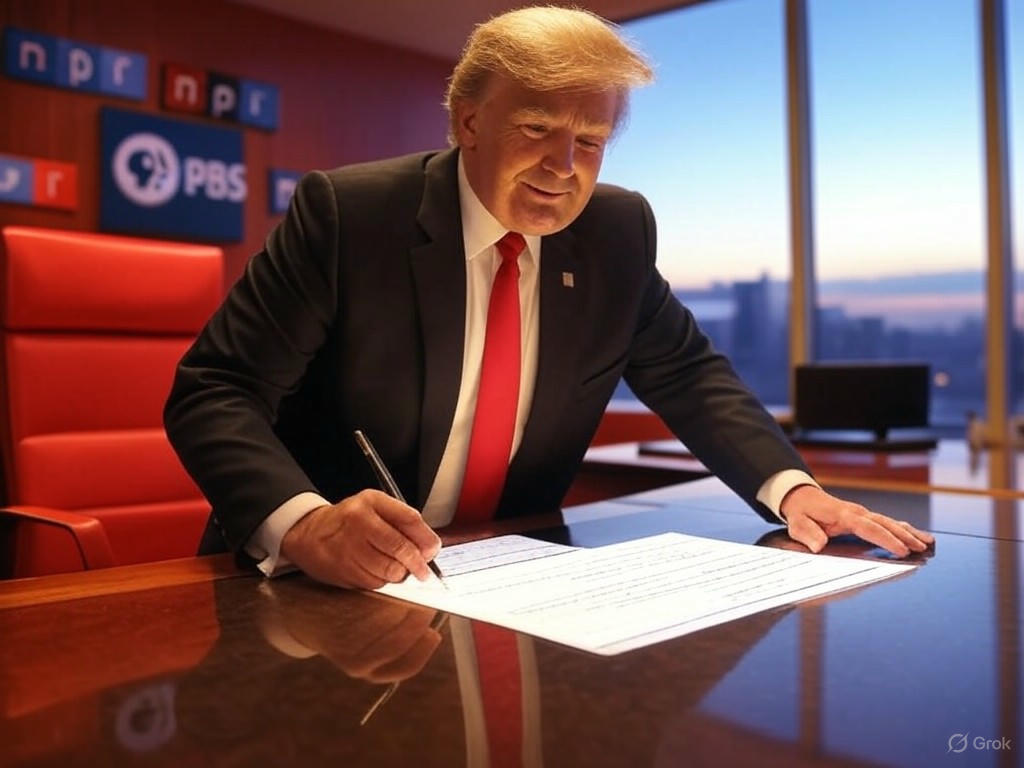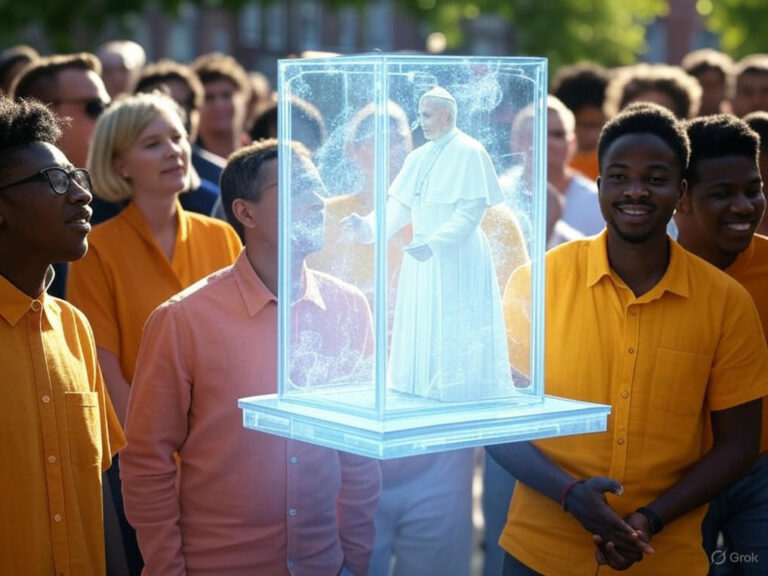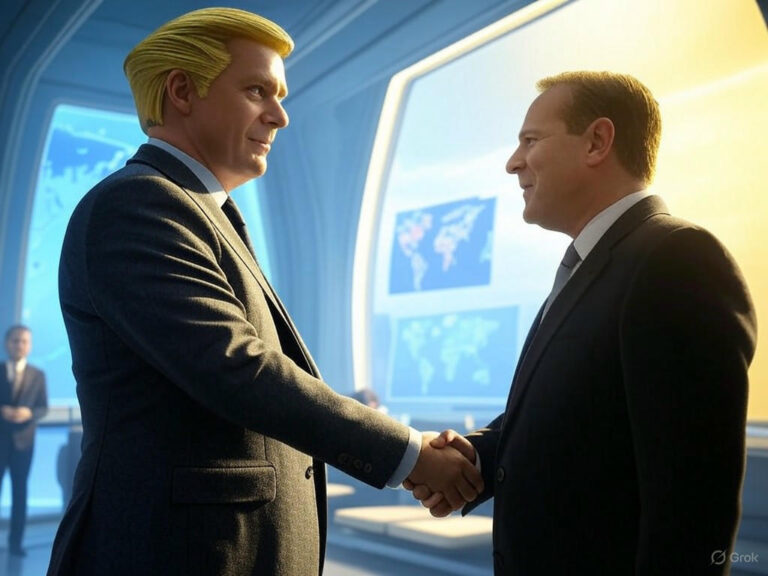
Trump Blocks PBS and NPR Funding in Major Executive Order
Have you ever wondered how political decisions can reshape the media we rely on daily? In a bold move that highlights ongoing tensions over media bias, Trump cuts funding to PBS and NPR through executive order, potentially altering the landscape of public broadcasting in America. Signed on May 1, 2025, this directive from President Donald Trump aims to halt federal support for these longstanding institutions, raising questions about government influence and journalistic independence.
How Trump Cuts Funding to PBS and NPR Through Executive Order
This executive order marks a pivotal shift in federal media policy, as Trump targets what he views as biased reporting from PBS and NPR. Issued while aboard Air Force One en route to Florida, the order instructs agencies like the Corporation for Public Broadcasting (CPB) to stop all federal funding immediately, wherever legally possible. Imagine the ripple effects: stations that deliver educational shows and local news could face immediate budget shortfalls.
The White House’s reasoning centers on claims that these outlets promote “radical, woke propaganda” rather than objective news. As the order states, PBS and NPR fail to offer a fair and unbiased view of events, which has long been a point of contention in political circles. But is this a step toward accountability or an overreach into media freedom? Let’s break it down.
Key Details of the Executive Order’s Directives
To fully grasp how Trump cuts funding to PBS and NPR through executive order, consider the two main components at play. First, it calls for an outright end to direct funding, compelling the CPB to cancel any existing grants as soon as feasible. Second, it blocks indirect support by preventing local stations from channeling federal money to these networks.
By June 30, 2025, the CPB must update its grant criteria to enforce this, effectively isolating PBS and NPR from taxpayer dollars. This isn’t just about cutting checks; it’s about redefining how public media operates in a polarized era. What might this mean for your favorite public radio shows or educational TV programs?
The Financial Toll on Public Broadcasting Networks
Federal funding forms a critical backbone for PBS and NPR, though not equally so. For PBS, it accounts for about 15% of its budget, while NPR relies on just 1% from these sources—still, the total impact is significant, with over half a billion dollars at stake annually.
- PBS CEO Paula Kerger has voiced concerns that many local stations could shut down without this support, emphasizing how it sustains community-valued programming.
- For NPR, the hit might be less severe, but it could still disrupt operations and limit reach in rural areas.
Think about it: without this funding, beloved shows that educate and inform might vanish, leaving gaps in access to quality journalism. How would communities adapt to such changes?
Exploring the Legal Hurdles of Trump’s Funding Cuts
The CPB is pushing back hard against this executive order, arguing that Trump oversteps his authority. As a private nonprofit, the CPB maintains it’s independent from direct presidential control, protected by congressional laws dating back to its creation.
CPB President Patricia Harrison has pointed out that federal statutes explicitly bar any executive interference in public broadcasting decisions. Legal experts predict court battles ahead, similar to those challenging other Trump-era policies on media funding. Could this set a precedent for future administrations?
Broader Patterns in the Administration’s Media Strategy
This action fits into a larger pattern where the Trump administration targets institutions seen as opposing its views. From ousting leaders at cultural organizations like the Kennedy Center to pushing universities to drop diversity programs, the approach is consistent.
- It’s extended to global media like Voice of America, with a recent executive order facing judicial blocks.
- Critics see this as an assault on independent media, questioning if it’s about bias or controlling narratives.
If you’re following politics closely, you might ask: Does this erode the principles of free press, or is it a necessary correction? Either way, it’s a reminder of how policy can influence what we hear and see.
Responses from Broadcasting Leaders and Experts
Leaders at PBS and NPR aren’t staying silent. Paula Kerger, for instance, defends PBS’s bipartisan history, stressing that its services are vital to the public and have always crossed political lines. Similarly, NPR’s executives have highlighted their independence in congressional testimonies, underscoring the unique role they play in American media.
These responses paint a picture of resilience, but they also raise practical questions: How can these organizations pivot to private funding without compromising their missions? Perhaps donations or corporate partnerships could fill the void, but that’s easier said than done.
The Historical Roots of Trump’s Funding Cuts to Public Media
Public broadcasting has weathered funding threats before, often from Republican critics citing liberal bias. Established in 1967 via the Public Broadcasting Act, the CPB was designed as a nonpartisan entity to deliver quality, educational content to all Americans.
Yet, this executive order represents the most aggressive attempt to dismantle that system. It’s a chapter in a long debate: Should government fund media at all, or leave it to the market? What do you think would happen if these outlets lost their federal ties entirely?
Future Implications for Public Media and Society
If Trump’s cuts to funding for PBS and NPR take full effect, we could see a transformed media environment. Local stations in underserved areas might scale back or close, limiting access to educational resources and local news that many depend on.
This could widen inequalities, especially in rural communities where alternatives are scarce. On a brighter note, innovation might emerge—perhaps through crowdfunding or new digital models. But with lawsuits pending and Congress holding the purse strings, the outcome is far from certain.
Navigating the Larger Political and Media Landscape
In today’s divided world, this executive order reflects deeper fights over media bias and government roles. Trump’s portrayal of PBS and NPR as partisan echoes ongoing discussions about objective journalism and public funding.
It challenges us to consider: What happens when politics interferes with information access? The resolution could influence not just broadcasting, but how we support education, culture, and free expression moving forward.
References
For more details, I’ve drawn from reliable sources. Here’s a quick list:
- “CPB Fires Back at Trump’s Executive Order Pulling Funding,” ABC News, link.
- White House Executive Actions, “Ending Taxpayer Subsidization of Biased Media,” link.
- “Trump Signs Executive Order Directing Federal Funding Cuts to PBS and NPR,” PBS NewsHour, link.
- Other sources include CBS News, OPB, Politico, Tribune, and PBS NewsHour articles, as referenced in the original material.
So, what’s your take on all this? If you’re passionate about public media, share your thoughts in the comments below, spread the word on social media, or check out our other posts on media policy for more insights. Let’s keep the conversation going!
Trump cuts funding to PBS and NPR through executive order, Trump executive order, PBS funding cut, NPR funding cut, Corporation for Public Broadcasting, federal media funding, public broadcasting, executive order media, Trump media policy, public radio funding







